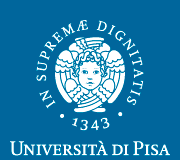
Contatti: bianca.gabbrielli@phd.unipi.it
Supervisore tesi: Prof. Carlo Pretti
Titolo Progetto: Sostenibilità delle produzioni in acquacoltura: sviluppo di coperture antifouling biocide-free per il trattamento di reti per gabbie galleggianti
Abstract: Il biofouling è una naturale successione ecologica che consiste nell’adesione e crescita di organismi su qualsiasi superficie sommersa nell’ambiente acquatico. Il processo di formazione delle incrostazioni sulle superfici sommerse può essere suddiviso in più fasi: deposito di macromolecole/particellato ed insediamento di microorganismi quali alghe unicellulari, batteri e funghi (microfouling) che costituiscono il pabulum idoneo a garantire l’adesione di altri organismi quali spore di macroalghe, larve di policheti, crostacei cirripedi, briozoi ed altro. Questi organismi, crescendo, vanno a costituire la componente del macrofouling. Il biofouling ha impatti multipli su molte attività antropiche legate al mare, quali la nautica e l’acquacoltura, in particolare l’acquacoltura off-shore condotta in gabbie galleggianti. Le gabbie galleggianti presentano il problema del biofouling delle reti. Questo comporta una ostruzione fisica delle maglie delle reti aumentando la resistenza idrodinamica (effetto vela) con rischio di rotture, appesantimento e diminuzione degli scambi con il mezzo circostante. Per questi motivi è pratica comune trattare le reti con vernici per uso nautico contenenti biocidi (derivati di rame e zinco, oltre a pesticidi/erbicidi agricoli) che permettono di prevenire l’adesione di organismi incrostanti. La presenza di biocidi, se da un lato contribuisce a mantenere l’efficienza delle strutture, comporta un lento e costante rilascio di sostanze chimiche che impattano sull’ambiente coinvolgendo anche organismi non-target. L’obiettivo del progetto consiste nella progettazione di coperture antifouling prive di biocidi, basate sul concetto del fouling-release (rilascio di fouling) che avviene in condizioni di moderate forze idrodinamiche (es. correnti). I risultati attesi sono la sintesi di polimeri antifouling applicabili a reti comunemente utilizzate in acquacoltura con caratteristiche di efficacia comparabili a reti trattate con vernici a base di biocidi, unitamente a caratteristiche di sostenibilità ambientale.
Project title: Sustainability of aquaculture production: development of biocide-free antifouling covers for the treatment of nets for floating cages
Abstract: Biofouling is a natural ecological succession that consists of the adhesion and growth of organisms on any submerged surface in the aquatic environment. The process of formation of fouling on submerged surfaces can be divided into several phases: deposition of macromolecules/particulates and settlement of microorganisms such as unicellular algae, bacteria, and fungi (microfouling) which constitute the pabulum suitable for ensuring the adhesion of other organisms such as spores of macroalgae, polychaete larvae, barnacle crustaceans, bryozoans and more. These organisms, as they grow, form the component of macrofouling. Biofouling impacts many human activities related to the sea, such as boating and aquaculture, particularly offshore aquaculture conducted in floating cages. Floating cages present the problem of net biofouling. This leads to physical obstruction of the mesh of the nets, increasing the hydrodynamic resistance with the risk of breakages, weighing them down, and decreasing exchanges with the surrounding medium. For these reasons, it is common practice to treat nets with paints for nautical use containing biocides (derivatives of copper and zinc, as well as agricultural pesticides/herbicides) which prevent the adhesion of encrusting organisms. The presence of biocides, while on the one hand contributing to maintaining the efficiency of the structures, involves a slow and constant release of chemical substances that impact the environment, also involving non-target organisms. The objective of the project consists of the design of biocide-free antifouling covers, based on the fouling-release concept which occurs in conditions of moderate hydrodynamic forces (e.g. currents). The expected results are the synthesis of antifouling polymers applicable to nets commonly used in aquaculture with efficacy characteristics comparable to nets treated with biocide-based paints, together with environmental sustainability characteristics.
Comunicazioni orali a congresso:
- Gabbrielli, B., Oliva, M., Fumagalli, G., Degl’Innocenti, D., Cuccaro, A., Pretti C. “Utilizing seagrass extracts for sustainable aquaculture”. 29th November 2024, Season Two – Games of Research, DSV-UNIPIsa Edition. Department of Veterinary Sciences, University of Pisa.Game of Research – Unipi Edition 2024.
Poster a congresso:
- Giannessi, J.,Cuccaro, A., De Marchi, L., Meucci, V., Intorre, L., Gabbrielli, B., Baratti, M., Pretti, C. The effects of ocean warming on the biochemical and transcriptional responses of Mediterranean mussels exposed to the fluoroquinolone antibiotic enrofloxacin. PRIMO22 International Symposium, 26-29 May 2024, Nantes, France. Premiato come migliore presentazione poster
- Gabbrielli, B., Oliva, M., Fumagalli, G., Degl’Innocenti, D., Cuccaro, A., Pretti C. “Utilizzo di estratti di fanerogame marine per un’acquacoltura sostenibile” XI Edizione delle Giornate Di Studio – Ricerca e applicazione di metodologie ecotossicologiche, 26-28 November 2024, Livorno
Premi:
- 1° premio comunicazione orale Gabbrielli, B., Oliva, M., Fumagalli, G., Degl’Innocenti, D., Cuccaro, A., Pretti C. “Utilizing seagrass extracts for sustainable aquaculture”. 29th November 2024, Season Two – Games of Research, DSV-UNIPIsa Edition. Department of Veterinary Sciences, University of Pisa.Game of Research – Unipi Edition 2024.
